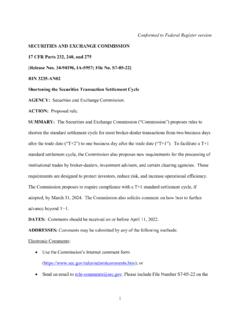Transcription of ONLINE SAFETY BILL - GOV.UK
1 bill CP 405-EN ONLINE SAFETY bill EXPLANATORY NOTES What these notes do These Explanatory Notes relate to the parts and clauses of the ONLINE SAFETY bill as published in draft on 12 May 2021 ( bill CP 405). These Explanatory Notes have been provided by the Department for Digital, Media, Culture and Sport and the Home Office in order to assist the reader of the bill . They do not form part of the bill and have not been endorsed by Parliament. These Explanatory Notes explain what each part of the bill will mean in practice; provide background information on the development of policy; and provide additional information on how the bill will affect existing legislation in this area. These Explanatory Notes might be best read alongside the bill . They are not, and are not intended to be, a comprehensive description of the bill . These explanatory notes relate to the ONLINE SAFETY bill as published in draft on 12 May 2021 ( bill CP 405) 2 Table of Contents Overview of the bill 4 Policy background 5 Interim Codes of Practice 6 Government Report on Transparency Reporting 6 Legal background 7 Territorial extent and application 9 Commentary on provisions of bill 10 Part 1: Overview and key definitions 11 Part 2: Providers of Regulated Services: Duties of Care 14 Chapter 1: Introduction 14 Chapter 2: Providers of user-to-user services: Duties of care 14 Chapter 3: Providers of search services: duties of care 22 Chapter 4: Assessment about access by children 27 Chapter 5: Codes of practice 29 Chapter 6: Interpretation of Part 2 36 Part 3: Other Duties of Service Providers 42 Chapter 1: Transparency Reports 43 Chapter 2: Fees 44 Part 4: OFCOM'S Powers and Duties in Relation to Regulated Services 49 Chapter 1: General Duties 49 Chapter 2.
2 Register of Categories of Services 50 Chapter 3: Risk assessments 56 Chapter 4: Use of technology in relation to terrorism content and child sexual exploitation and abuse content 57 Chapter 5: Information 61 Chapter 6: Enforcement Powers 71 Chapter 7: Committees, research and reports 87 Chapter 8: Media literacy 90 Part 5: Appeals and Super-complaints 92 Chapter 1: Appeals 92 Chapter 2: Super-complaints 93 Part 6: Secretary of State s Functions in Relation to Regulated Services 96 Part 7: General and Final Provisions 100 Financial implications of the bill 114 Compatibility with the European Convention on Human Rights 115 These explanatory notes relate to the ONLINE SAFETY bill as published in draft on 12 May 2021 ( bill CP 405) 3 Related documents 116 Annex A Glossary 117 Annex B - Territorial extent and application in the United Kingdom 119 Subject matter and legislative competence of devolved legislatures 121 These explanatory notes relate to the ONLINE SAFETY bill as published in draft on 12 May 2021 ( bill CP 405) 4 Overview of the bill 1.
3 The ONLINE SAFETY bill establishes a new regulatory regime to address illegal and harmful content ONLINE , with the aim of preventing harm to individuals in the United Kingdom. It imposes duties of care in relation to illegal content and content that is harmful to children on providers of internet services which allow users to upload and share user-generated content ( user-to-user services ) and on providers of search engines which enable users to search multiple websites and databases ( search services ). 2. The bill also imposes duties on such providers in relation to the protection of users rights to freedom of expression and privacy. Providers of user-to-user services which meet specified thresholds ( Category 1 services ) are subject to additional duties in relation to content that is harmful to adults, content of democratic importance and journalistic content. 3. The bill confers powers on the Office of Communications (OFCOM) to oversee and enforce the new regulatory regime (including dedicated powers in relation to terrorism content and child sexual exploitation and abuse (CSEA) content), and requires OFCOM to prepare codes of practice to assist providers in complying with their duties of care.
4 The bill also expands OFCOM s existing duties in relation to promoting the media literacy of members of the public. These explanatory notes relate to the ONLINE SAFETY bill as published in draft on 12 May 2021 ( bill CP 405) 5 Policy background 4. With the increasing use of the internet has come an increasing awareness that ONLINE content can cause serious harm to users and other individuals in the United Kingdom. The prevalence of the most serious illegal content and activity ONLINE is unacceptable, and it threatens the United Kingdom s national security and the physical SAFETY of children. There were more than 69 million images and videos related to child sexual exploitation and abuse referred by US technology companies to the National Center for Missing and Exploited Children in 2019, an increase of more than 50% on the previous year. 5. Alongside illegal content and activity, there are increasing levels of public concern about ONLINE content and activity which is lawful but potentially harmful.
5 This type of activity can range from ONLINE bullying and abuse, to advocacy of self-harm, to spreading disinformation and misinformation. Whilst this behaviour may fall short of amounting to a criminal offence, it can have corrosive and damaging effects, creating toxic ONLINE environments and negatively impacting users ability to express themselves ONLINE . 6. The bill is intended to make the services it regulates safer by placing responsibilities on the providers of those services in relation to content that is illegal or which, although legal, is harmful to children or adults. 7. The ONLINE Harms White Paper, published in April 2019, set out the intention to improve protections for users ONLINE through the introduction of a new duty of care on companies and an independent regulator responsible for overseeing this framework. It proposed that this regulation follow a proportionate and risk-based approach, and that the duty of care be designed to ensure that all companies have appropriate systems and processes in place to address harmful content and improve the SAFETY of their users.
6 8. A public consultation on the White Paper proposals ran from 8 April 2019 to 1 July 2019. It received over 2,400 responses ranging from companies in the technology industry including large tech giants and small and medium sized enterprises, academics, think tanks, children s charities, rights groups, publishers, governmental organisations and individuals. 9. In February 2020, the government published an initial response to the consultation, providing an in-depth breakdown of the responses to each of the 18 consultation questions asked in relation to the White Paper proposals. The response also set out the government's direction of travel in a number of key areas, including: a. How the new regulatory framework would ensure protections for users rights by including safeguards in the legislation; b. The differentiated approach to illegal and legal material; c. How the new requirements would be proportionate and risk-based, including clarifying who would not be captured by the proposed scope; d.
7 A commitment to delivering a higher level of protection for children; and These explanatory notes relate to the ONLINE SAFETY bill as published in draft on 12 May 2021 ( bill CP 405) 6 e. That the government was minded to appoint OFCOM as the new regulator. 10. In December 2020, the full government response to the consultation was published, outlining the final policy position for the ONLINE SAFETY regulatory framework, and the government's intention to enshrine it in law through the ONLINE SAFETY bill . The response was split into seven parts: a. Part 1 stated that the regulatory framework would apply to companies whose services host user-generated content or facilitate interaction between users, one or more of whom is based in the UK, as well as to search engines. b. Part 2 outlined that the legislation would set out a general definition of the harmful content and activity covered by the duty of care. It also set out how all companies in scope would be required to understand the risk of harm to individuals on their services, and to put in place appropriate systems and processes to improve user SAFETY and monitor their effectiveness.
8 C. Part 3 confirmed that OFCOM would be appointed as the regulator, and outlined its regulatory functions and funding. d. Part 4 explained the proposed functions of the regulator, including its duty to set out codes of practice, enforcement powers, and user redress mechanisms. e. Part 5 outlined the role of technology, education, and awareness in tackling ONLINE harms. f. Part 6 explained how the new regulatory framework would fit into the wider digital landscape, including as part of the government s Digital Strategy. g. Part 7 provided the next steps for the regime, including the expected timings for the ONLINE SAFETY bill . Interim Codes of Practice 11. The government published two interim codes of practice covering terrorist content and child sexual exploitation and abuse (CSEA) content ONLINE alongside the full government response. These interim codes set out the voluntary action the government expects providers to take to tackle the most serious categories of harmful content ONLINE before the regulator is established.
9 Government Report on Transparency Reporting 12. The first government report on transparency reporting in relation to ONLINE harms was published alongside the full government response. This presented the recommendations of the multi-stakeholder transparency working group, set up in October 2019, about how the transparency framework could work in practice within the new ONLINE harms regulatory framework. These explanatory notes relate to the ONLINE SAFETY bill as published in draft on 12 May 2021 ( bill CP 405) 7 Legal background 13. The ONLINE SAFETY bill repeals the following existing legislative provisions which relate to the regulation of internet services: a. Part 3 of the Digital Economy Act 2017 ( ONLINE pornography); b. Section 103 of the Digital Economy Act 2017 (code of practice for providers of ONLINE social media platforms); and c. Part 4B of the Communications Act 2003 (video-sharing platform services) and Part 4 of the Audiovisual Media Services Regulations 2020 ( 2020/1062) (which inserts Part 4B into the Communications Act 2003).
10 14. OFCOM was established by the Office of Communications Act 2002. The bill amends OFCOM s general duties, as set out in section 3 of the Communications Act 2003, to extend them in relation to ONLINE SAFETY matters, and substitutes revised provisions for OFCOM s existing duty to promote media literacy in section 11 of that Act. 15. Prior to the UK s exit from the European Union, the legal framework for the regulation of ONLINE services was primarily set out in the EU e-Commerce Directive (eCD)1. The eCD detailed the rules for ONLINE service providers in respect of transparency and information requirements, rules for cooperation between member states, and, most importantly for the bill s purposes, a framework limiting the liability of ONLINE intermediaries for the content they host on their services. 16. The eCD prevented member states from imposing liability on service providers who provide a service that consists of the storage of information provided by the recipient of the service for content created by users, so long as the provider does not have actual knowledge of illegal activity or information and.













